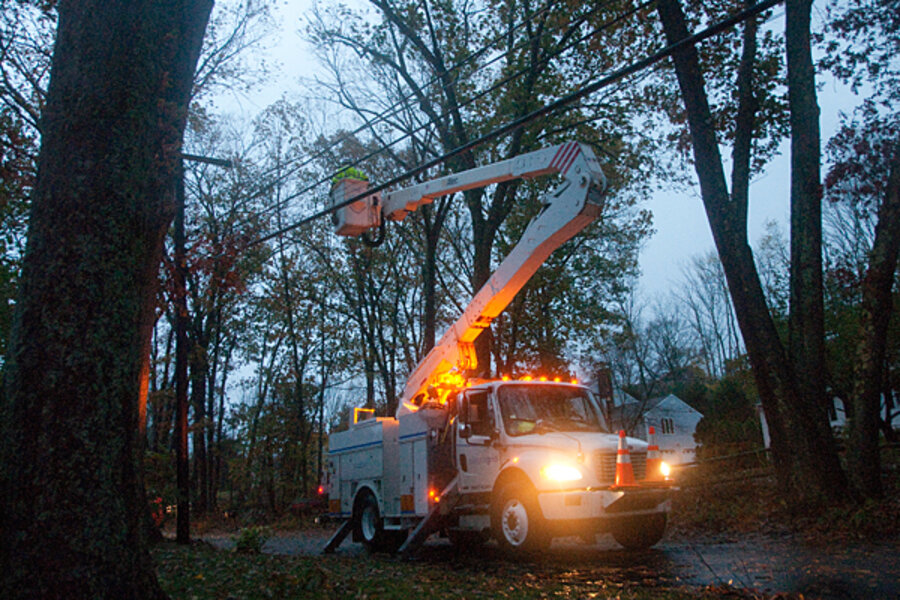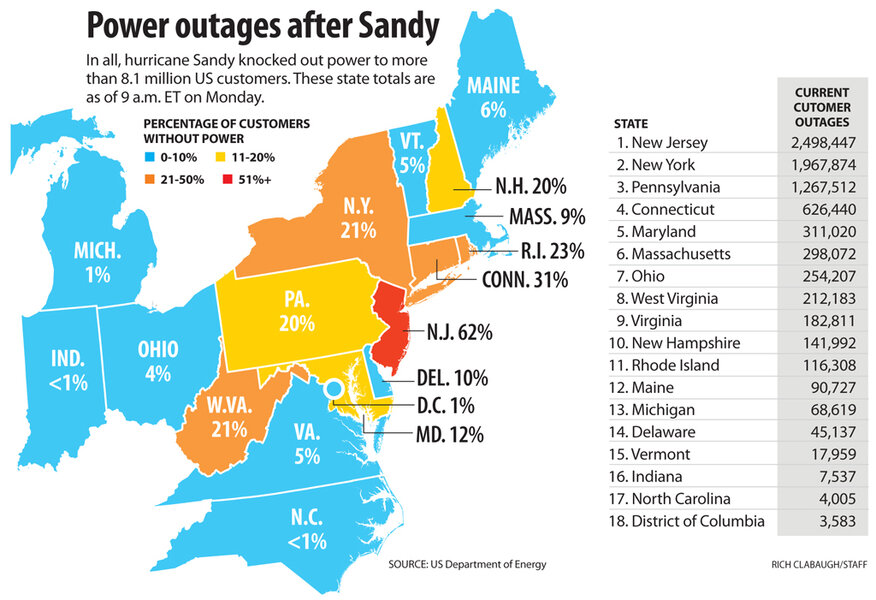Hurricane Sandy: with 8.1 million in the dark, utility crews get busy
More than 8.1 million customers in 17 states were left in the dark in the wake of hurricane Sandy, which smashed ashore Monday night in New Jersey and immediately began dismantling chunks of the Eastern power grid.
In terms of its outage impact, hurricane Sandy was roughly on par with hurricane Irene, which in August 2011 knocked out power to more than 9.3 million customers along the East Coast and in Puerto Rico – about 6 million in 13 East Coast states.
But Sandy's impact was more concentrated than Irene's, doing the bulk of its damage in fewer but more heavily populated states. Most of the outages were in eight states: New Jersey, New York, Pennsylvania, Connecticut, Maryland, Massachusetts, Ohio, and West Virginia – some 7.4 million customers.
"The magnitude of this event is really huge," says Mark Merritt, president of Witt Associates, a public-safety and crisis-management consulting firm in Washington. "From North Carolina to Maine, utilities are dealing with coastal power issues from flooding to snow impacts in the mountains of Virginia and West Virginia. A lot of these companies, public and private, are competing for limited resources, scrambling, so it's a challenge for everyone."
With crews coming from all over, even the West Coast, hurricane Sandy has become an "an all-hands-on-deck-type event," Mr. Merritt says. Still, there were signs that power restoration could be slow in some of the hardest-hit areas.
Restoration of power in New York, for one, is going to be exceedingly complex, with blown transformers, flooded underground utilities, and waterlogged subways. Repairs may go more slowly than many had hoped, despite the high level of preparation by utility companies.
Excessive flooding from the storm surge knocked out a number of substations in New Jersey’s Essex, Hudson, and Middlesex counties, according to the utility Public Service Electric and Gas (PSE&G). Those stations, which serve about 462,000 customers, will be out of service until the water recedes and equipment can be cleaned and dried, the utility reported.
Consolidated Edison, a big New York utility, said first reports indicated more than 200 wires down on Staten Island. The company cut service overnight to two sections of lower Manhattan and a chunk of Brooklyn to protect underground delivery systems from floodwaters. The electrical equipment there would then have to have all components cleaned of seawater, dried, and tested.
Meanwhile, three nuclear power plants in the northeastern United States had to shut down, and two units cut back their power output as a result of effects from hurricane Sandy, the US Nuclear Regulatory Commission reported.
PSEG Nuclear manually shut down its Salem Unit 1 in southern New Jersey at 1:09 a.m. Monday when four of the station’s six circulating water pumps became unavailable due to weather impacts. Circulating water pumps use water from Delaware Bay to condense steam on the nonnuclear side of the plant.
Entergy Nuclear also shut down its Indian Point Unit 3 reactor, 38 miles north of New York City, at 10:45 p.m. on Monday "due to external electrical grid issues," the company reported. About two hours earlier, at 9 p.m., Constellation Energy reported that its Nine Mile Unit 1 near Oswego, N.Y., had experienced an automatic reactor shutdown whose cause was being investigated.
Two of six refineries were shut down as of Tuesday morning, with the four others operating at reduced capacity, the Energy Department reported.
At a news conference, New Jersey Gov. Chris Christie (R) spoke of homes knocked off foundations and amusement-park rides rammed into the sea. “The level of devastation on the Jersey Shore is unthinkable,” he said.
Governor Christie, who has indicated a distinct disinterest in the presidential election, nevertheless praised President Obama on his response to, and preparation for, the storm.
"The president has been all over this. He deserves great credit.... He gave me his number at the White House, told me to call if I needed anything, and he absolutely means it,” he said. “It's been very good working with the president, and his administration has been coordinating with us great."
According to some early estimates from economists, hurricane Sandy, with its massive flooding, is more akin to hurricane Katrina than hurricane Irene. Katrina was the nation’s most expensive natural disaster, costing about $41 billion in property damage, according to one insurance company report.
Now the race begins to see how fast electricity can be restored to limit the overall economic damage. Utilities have been under pressure since major power outages from storms last year to do a better job this time. To that end, they have prepositioned thousands of line crews from out of state. Now politicians and customers will be waiting – and waiting – to see how long it takes.
“We expected an unprecedented storm,” New York City Mayor Michael Bloomberg said at a press conference Tuesday morning. “That’s what we got.”







